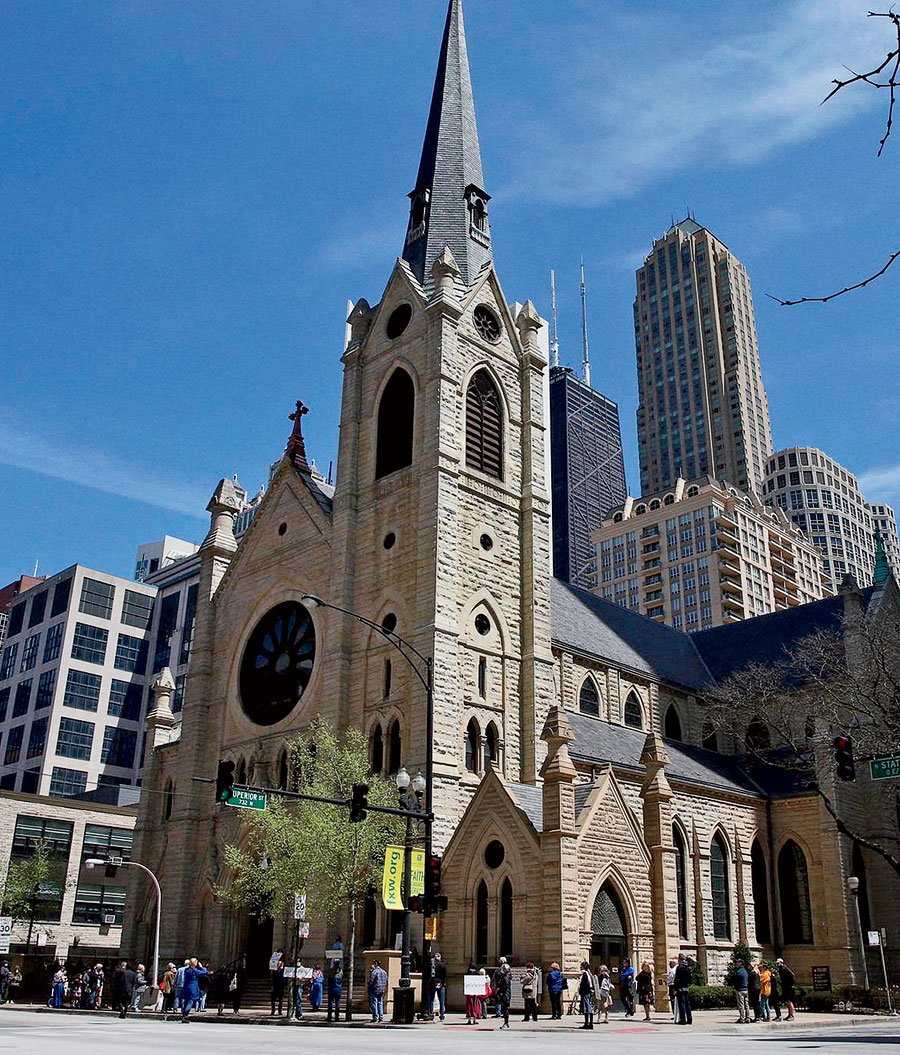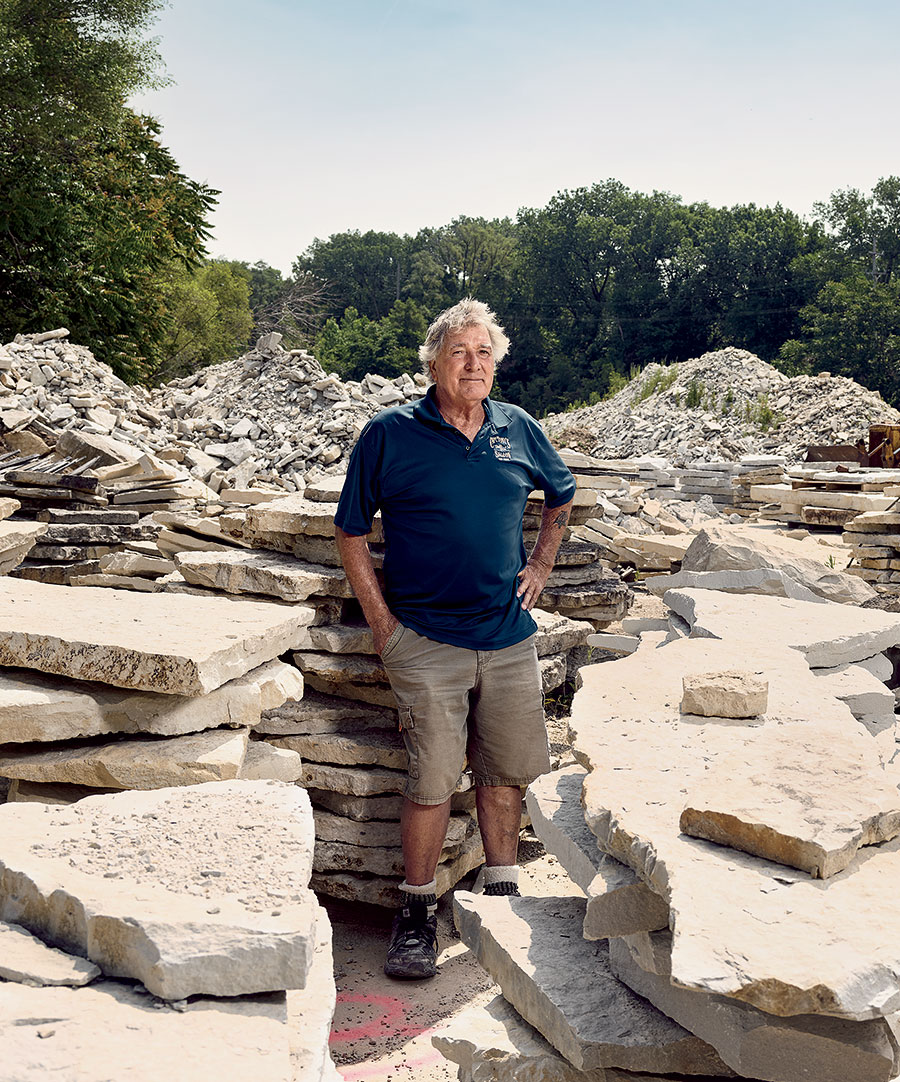You don’t notice the ground until someone points it out. Visiting Bromberek Flagstone in Joliet, I mention to the quarry’s owner, Larry Bromberek, that I expected a vast, yawning chasm, not a flat grayish-white moonscape. Dressed in shades of faded blue — T-shirt, jeans, and a button-down shirt, with dust-covered black shoes — Bromberek, 70, nods and gestures to the north side, then takes me over to an eight-foot-high cross section of the earth. As Interstate 80 grumbles and thrums nearby, he identifies the sundry layers revealed by 30 years of mining. Up top is the overburden, a collection of soil, sand, silt, and grit. Below that are several staggered levels of yellowish rock, a fragment of the Sugar Run dolomite formation that rests beneath the area. It’s commonly known as Joliet-Lemont limestone.
Discovered in the late 1840s during the digging of the I&M Canal, Sugar Run dolomite was used to line the waterway, which still runs from Chicago to La Salle, Illinois. It’s a durable and affordable building material, and its ability to slowly transform from gray to a pleasant creamy brown made it a popular choice for homes, churches, and civic and commercial buildings. Enabled by railroads and canals, quarries in Joliet, Lemont, and Lockport delivered stone to Chicago and elsewhere, marketing it as Athens Marble, among other trade names. Even if you’ve never heard of Joliet-Lemont limestone, you’ve probably seen it: Several well-known local structures were built with the material, including Holy Name Cathedral, Rosehill Cemetery’s gate, and the Great Chicago Fire’s most famous survivor, the Water Tower.
By the 1890s, 25 quarries were pulling up Joliet-Lemont limestone in the Des Plaines Valley region, selling it to builders and developers across the country. But fashions and tastes changed, the 19th-century building boom quieted, and demand dropped. Only one quarry remains: Bromberek Flagstone in Joliet. Soon there will be none. The quarry’s days are winding down. Bromberek sold the property to a local construction company and has to vacate by September. Once he’s gone, there’ll be no one left to pry the historic construction material out of the ground.
Bromberek’s parents established the business in the 1940s. Bromberek Flagstone has worked several quarries around Joliet and Lemont, but has maintained the one at 620 Sandall Place in Joliet for 30 years, primarily supplying landscapers as well as conservators and restorers. Meanwhile, other quarries closed as demand sank and owners retired or died. Bromberek says his current quarry was first owned by the Napoli Stone Co. and mined between the 1920s and 1972, closing after the death of that company’s owner — a common thread. Looking back over the decades, Bromberek describes the small community of quarrymen not as competitors but more as friends: “We all knew each other.”
Bromberek’s appearance is both weathered and vital. Topped with a wild thatch of salt-and-pepper hair — “I’m trying to get the Rod Stewart,” he says with a grin, running his hand through it — his ruddy face has seen its share of the sun. He seems both wistful and practical about his last-merchant-standing status: “Just a history of people having [quarries], passing away, and nobody wants to take them over or continue it, so I’m the last.”
As the only source of this stone, Bromberek Flagstone remains in moderate demand. No one builds massive limestone city halls, cathedrals, and courthouses anymore, but there are other uses. Landscapers account for 80 to 90 percent of Bromberek’s business. They prefer the rock for its natural beauty, durability, affordability, and local availability when constructing retaining walls, edging, creeks, and waterfalls. The Forest Preserve District of Will County has used Bromberek’s stone to line ponds, provide steppingstones, and build stairs for its Sugar Creek Administration Center and decorative berms at the entrance of the Rock Run Preserve in Joliet. Personalized stone signs are another market: incising slabs to commemorate birthdays and anniversaries and mark subdivision entrances.

Bromberek’s stone has given second life to many 19th-century Joliet-Lemont limestone edifices. A century of wind, rain, heat, and cold does plenty of damage, and many restorers show up seeking new stone from the original source to mend and remodel foundations and façades. Bromberek Flagstone has provided limestone to repair, for instance, a historic train station and St. Dennis Church in Lockport, as well as the grotto at Saints Peter and Paul Cemetery in Naperville. A few years ago, Bromberek furnished stone to restore a portico and staircase at the Vanderbilt Mansion National Historic Site in Hyde Park, New York. After quarrying the stone, Bromberek took it to a fabricator to have it fashioned to the restorer’s specs before shipping it to New York. The fabrication is necessary for fancier projects, as fresh limestone is naturally rough and fragmented.
Walking over to another section of the quarry, I notice newly revealed stone, angular and gleaming. Limestone chunks of varying sizes are neatly stacked beside other kinds of stone brought from quarries around the nation. Bromberek imports quartzite, bluestone, porphyry, and sandstone to Joliet, but limestone dominates the scenery. Gesturing at a long stretch of unquarried rock resembling uncooked tofu, he points out the thin layers of long-dried clay in between. A Caterpillar track loader pulls it up, its bucket’s teeth biting into the rock, busting the clay and bringing up the stone in thicknesses of one inch, two inches, three, or more. Limestone is fickle. “It comes up naturally the way it wants to come up,” Bromberek explains.
Limestone is a sedimentary rock made from the remains of ancient sea life — corals, shells, and bones resting at the bottom of long-gone oceans — that are eventually compressed into the material we know and love. That means the quarry doubles as a geologic museum. “We find fossils and stuff,” Bromberek says. “Trilobites, cephalopods, coral, and stuff like that.” The company’s website offers loose limestone at 14 cents a pound or $280 a ton, and includes this guarantee: “Every stone, no matter the size, thickness, or if it contains a rare fossil, is the exact same price per pound.” No major finds, à la Sue the T. rex, of course, though the occasional rock hound has shown up and left with some stony souvenir.
If you’re in the market for that classic buttery-tan Joliet-Lemont limestone, you need to hurry. Bromberek Flagstone sold the property to the PT Ferro Construction Co. next door, so this summer is your last chance to buy its signature product. Once Bromberek Flagstone vacates the site, it’s unlikely anyone will quarry for the historic stone that built a good part of early Chicago.
Bromberek is still pondering his future. Despite past health issues, he has no plans to retire. He may move, continuing to import other stone and bringing as much already mined limestone from the quarry as possible. But unless someone else opens another local quarry, when he sells his last pebble of Joliet-Lemont limestone, that’s it. “Nobody else around is gonna do it that I know of. And I know everybody that knows everything about the stone business,” Bromberek says. “There’s nobody that’s gonna do what I do.”
It’s a reminder, perhaps, that while diamonds, rubies, and emeralds get the glory, any stone can be a precious one. Especially when it’s gone.



